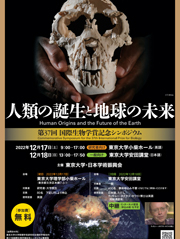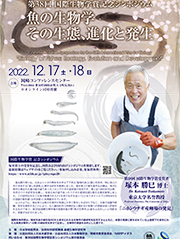International Prize for Biology
2021 and 2022 Presentation Ceremony, Acceptance Address, Selection Process
Presentation Ceremony
for the 2021 and 2022 International Prizes for Biology was held
in the Presence of Their Imperial Highnesses the Crown Prince and Crown Princess
on December 14
for the 2021 and 2022 International Prizes for Biology was held
in the Presence of Their Imperial Highnesses the Crown Prince and Crown Princess
on December 14
37th Prize Recipient
Dr. Timothy Douglas White, Professor of Integrative Biology, University of California at Berkeley, USA
38th Prize Recipient
Dr. TSUKAMOTO Katsumi, Professor Emeritus, The University of Tokyo, Japan
On December 14, a presentation ceremony for the 2021 and 2022 International Prizes for Biology was held at the Japan Academy in the presence of Their Imperial Highnesses the Crown Prince and Crown Princess, Mr. HOSHINO Tsuyoshi, State Minister of Cabinet Office, and Ms. NAGAOKA Keiko, Minister of Education, Culture, Sports, Science and Technology (MEXT).
At the ceremony, Dr. White and Mrs. Tsukamoto, who attended on behalf of Dr. Tsukamoto, were presented the Prize of 10-million yen and a medal by Dr. FUJIYOSHI Yoshinori, Chair of the International Prize for Biology Committee, along with an Imperial gift from the Crown Prince.
Following remarks offered by the Crown Prince, congratulatory messages were delivered by Prime Minister KISHIDA Fumio (read by Mr. Hoshino) and MEXT Minister Nagaoka. The ceremony concluded with acceptance addresses from Dr. White and Dr. Tsukamoto (read by Mrs. Tsukamoto). After the ceremony, a gathering to honor the Prize recipients was held in the presence of the Crown Prince and Princess.
At the ceremony, Dr. White and Mrs. Tsukamoto, who attended on behalf of Dr. Tsukamoto, were presented the Prize of 10-million yen and a medal by Dr. FUJIYOSHI Yoshinori, Chair of the International Prize for Biology Committee, along with an Imperial gift from the Crown Prince.
Following remarks offered by the Crown Prince, congratulatory messages were delivered by Prime Minister KISHIDA Fumio (read by Mr. Hoshino) and MEXT Minister Nagaoka. The ceremony concluded with acceptance addresses from Dr. White and Dr. Tsukamoto (read by Mrs. Tsukamoto). After the ceremony, a gathering to honor the Prize recipients was held in the presence of the Crown Prince and Princess.
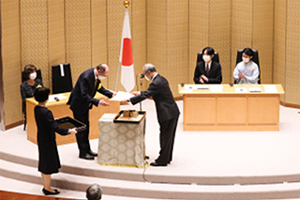
Dr. White receiving the Award
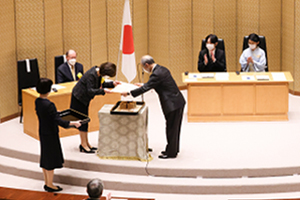
Mrs. Tsukamoto receiving Dr. Tsukamoto’s Award
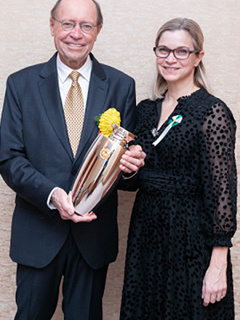
Holding their Imperial gifts
Dr. White and spouse Dr. Hlusko
Dr. White and spouse Dr. Hlusko
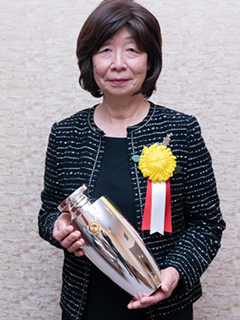
Holding their Imperial gifts
Mrs. Tsukamoto
Mrs. Tsukamoto
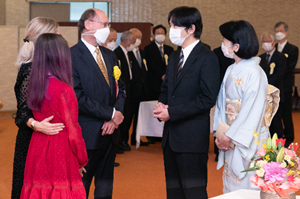
After-ceremony gathering with Crown Prince and Princess
Dr. White and his family
Dr. White and his family
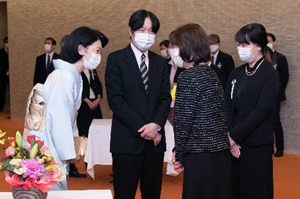
After-ceremony gathering with Crown Prince and Princess
Dr. Tsukamoto’s family
Dr. Tsukamoto’s family
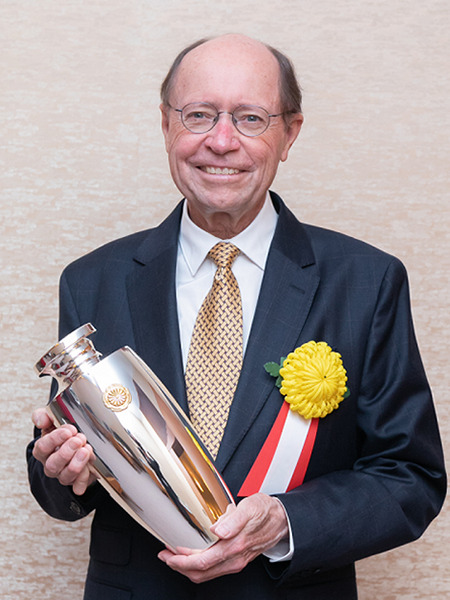
Your Imperial Highnesses, your Excellencies, colleagues and friends:
I am humbled to receive the 37th International Prize for Biology. And I am honored by the organization of this very special ceremony; and by your presence. Together we commemorate the pioneering research of the Japan’s Emperor-scientists.
Today’s participation of your Imperial Highnesses—the Crown Prince and Princess—is a powerful reminder of Japan’s leadership and commitment to global science. I thank you personally, on behalf of all scientists, for your support, and for your leadership.
This Prize became the world’s premiere recognition of basic biological research because of this vision and leadership. And because of the combined work of thousands of people here in Japan over the last four decades. All of the recipients of this Prize have been world-class scholars chosen through your rigorous nomination and review process—a process held in the highest international esteem.
I extend my thanks to the entire Japan Society for the Promotion of Science. I am grateful for the amazing organizational work of the Secretariat under difficult circumstances. And for the exhaustive work of the Selection Committee under the guidance of Chairperson Dr. MIMURA Tetsuro. And for the steadfast, generous, and continuing support that the Society gives the entire scientific enterprise.
For human evolutionary studies in particular, the Society itself deserves to share this prize because of its long support for field and laboratory research, and especially for capacity building in Africa.
Special thanks to Professor Katsumi Tsukamoto and his family for graciously sharing this combined ceremony for the 37th and 38th Prizes.
This Prize is always given to single individuals. But I cannot accept this alone. I would not be here had my parents not given me the freedom to pursue my curiosity about the past. I would not be here without the support and the sacrifices of many teachers, friends, and colleagues from all walks of life, and all levels of education.
They welcomed me into their countries, their cultures, their laboratories and museums, and often into their homes.
In all of these countries, and all of these cultures, family is central. And that is why I am so deeply touched to share this occasion, indeed this prize, with my wife, Professor Leslea Hlusko, and our daughter Madsen. We treasure the opportunity that you have given us to introduce our daughter to the people, the history, the culture, and the potential of Japan.
Accomplishments honored by individual prizes are only made possible by the combined efforts of many. This is especially true for this Prize in the Biology of Human Evolution.
The Middle Awash science project originated in the pioneering surveys of the late French geologist Maurice Taieb. While he was exploring the Ethiopian Afar, I had the privilege of learning fieldwork from the late great Kenyan fossil finder and teacher, Kamoya Kimeu.
The extraordinary public university systems of California and Michigan supported my academic studies.
As a young PhD I was fortunate to have the guidance and support of Desmond Clark and Clark Howell, icons of 20th Century paleoanthropology. Their multidisciplinary approaches created a platform at Berkeley from which the distinguished careers of my long-term colleagues Drs. Gen Suwa and Berhane Asfaw were launched. And then the careers of many other younger scholars now making their own important discoveries.
Our Middle Awash research team includes scientists from 17 countries. During the last four decades more than 700 team members have integrated their special skills to explore our deeply shared past.
Our research has crossed many continental and national boundaries, involved several generations, and encompassed many different cultures.
The participants are geologists, geochronologists, archaeologists, paleobotanists, paleontologists, antiquities officers, students, drivers, cooks, mechanics, guards, guides, and villagers. Most of these people have worked in the field under extreme and often dangerous conditions. Also sharing the Prize are the people of Ethiopia, particularly those of the Afar Regional State whose lands hold the secrets of deep time.
I am deeply honored and grateful for the recognition that this Prize bestows upon all of us. And by the support that it gives to the international science of paleobiology.
Your Prize inspires all of us to continue these research and educational efforts. There is much more to be learned about our origins and evolution. We hope that the perspectives that our discoveries afford will help our species to shape a more peaceful and sustainable future.
Thank you. Hontoni arigato gozaimasu.
I am humbled to receive the 37th International Prize for Biology. And I am honored by the organization of this very special ceremony; and by your presence. Together we commemorate the pioneering research of the Japan’s Emperor-scientists.
Today’s participation of your Imperial Highnesses—the Crown Prince and Princess—is a powerful reminder of Japan’s leadership and commitment to global science. I thank you personally, on behalf of all scientists, for your support, and for your leadership.
This Prize became the world’s premiere recognition of basic biological research because of this vision and leadership. And because of the combined work of thousands of people here in Japan over the last four decades. All of the recipients of this Prize have been world-class scholars chosen through your rigorous nomination and review process—a process held in the highest international esteem.
I extend my thanks to the entire Japan Society for the Promotion of Science. I am grateful for the amazing organizational work of the Secretariat under difficult circumstances. And for the exhaustive work of the Selection Committee under the guidance of Chairperson Dr. MIMURA Tetsuro. And for the steadfast, generous, and continuing support that the Society gives the entire scientific enterprise.
For human evolutionary studies in particular, the Society itself deserves to share this prize because of its long support for field and laboratory research, and especially for capacity building in Africa.
Special thanks to Professor Katsumi Tsukamoto and his family for graciously sharing this combined ceremony for the 37th and 38th Prizes.
This Prize is always given to single individuals. But I cannot accept this alone. I would not be here had my parents not given me the freedom to pursue my curiosity about the past. I would not be here without the support and the sacrifices of many teachers, friends, and colleagues from all walks of life, and all levels of education.
They welcomed me into their countries, their cultures, their laboratories and museums, and often into their homes.
In all of these countries, and all of these cultures, family is central. And that is why I am so deeply touched to share this occasion, indeed this prize, with my wife, Professor Leslea Hlusko, and our daughter Madsen. We treasure the opportunity that you have given us to introduce our daughter to the people, the history, the culture, and the potential of Japan.
Accomplishments honored by individual prizes are only made possible by the combined efforts of many. This is especially true for this Prize in the Biology of Human Evolution.
The Middle Awash science project originated in the pioneering surveys of the late French geologist Maurice Taieb. While he was exploring the Ethiopian Afar, I had the privilege of learning fieldwork from the late great Kenyan fossil finder and teacher, Kamoya Kimeu.
The extraordinary public university systems of California and Michigan supported my academic studies.
As a young PhD I was fortunate to have the guidance and support of Desmond Clark and Clark Howell, icons of 20th Century paleoanthropology. Their multidisciplinary approaches created a platform at Berkeley from which the distinguished careers of my long-term colleagues Drs. Gen Suwa and Berhane Asfaw were launched. And then the careers of many other younger scholars now making their own important discoveries.
Our Middle Awash research team includes scientists from 17 countries. During the last four decades more than 700 team members have integrated their special skills to explore our deeply shared past.
Our research has crossed many continental and national boundaries, involved several generations, and encompassed many different cultures.
The participants are geologists, geochronologists, archaeologists, paleobotanists, paleontologists, antiquities officers, students, drivers, cooks, mechanics, guards, guides, and villagers. Most of these people have worked in the field under extreme and often dangerous conditions. Also sharing the Prize are the people of Ethiopia, particularly those of the Afar Regional State whose lands hold the secrets of deep time.
I am deeply honored and grateful for the recognition that this Prize bestows upon all of us. And by the support that it gives to the international science of paleobiology.
Your Prize inspires all of us to continue these research and educational efforts. There is much more to be learned about our origins and evolution. We hope that the perspectives that our discoveries afford will help our species to shape a more peaceful and sustainable future.
Thank you. Hontoni arigato gozaimasu.
Distinguished guests, ladies and gentlemen:
On behalf of the Selection Committee for the 37th International Prize for Biology, it gives me great pleasure to report on the selection process.
The Selection Committee comprised twenty members, including myself and four overseas researchers.
This year’s field of specialization for the Prize was the Biology of Human Evolution. To obtain recommendations of suitable candidates, the Committee distributed a total of 1,607 recommendation forms to Japanese and foreign universities, research centers, academic associations, international academic organizations, and others. A total of 21 recommendations were received in response. After excluding recommendations naming the same individuals, the number of persons recommended was 17, from 10 countries and regions.
Due to the ongoing pandemic, the Selection Committee met online, for a total of four times. After carefully reviewing all the candidates, the Committee recommended Professor Timothy Douglas White to the Prize Committee as the recipient of the 37th International Prize for Biology.
After obtaining a PhD at the University of Michigan, Professor White has spent many years in research and education at the University of California, Berkeley. As a co-leader with Ethiopian researchers in a survey project in Ethiopia, he was involved in the discovery of fossils from various stages in human evolution. Presenting new evidence and interpretations based on analyses of these fossils, he contributed greatly to our understanding of human evolution.
Among his most noteworthy achievements was the discovery of the 4.4- million-year-old Ardipithecus ramidus fossils. This outstanding accomplishment made by Professor White along with the joint international research team has given us a wealth of knowledge about our earliest human ancestors, which had previously been unknown, dramatically advancing studies of human evolution.
The selection criteria for this Prize consisted of the relevance of the candidate’s research to the selected field of biology, its originality, its influence on that field of biology, and its contribution to advancing biological science as a whole. Professor White’s work more than amply satisfied all these selection criteria.
Based on our recommendation, the Committee on the International Prize for Biology deliberated and decided to award the 37th International Prize for Biology to Professor Timothy Douglas White.
With this, I conclude my report on the process of the Prize selection.
On behalf of the Selection Committee for the 37th International Prize for Biology, it gives me great pleasure to report on the selection process.
The Selection Committee comprised twenty members, including myself and four overseas researchers.
This year’s field of specialization for the Prize was the Biology of Human Evolution. To obtain recommendations of suitable candidates, the Committee distributed a total of 1,607 recommendation forms to Japanese and foreign universities, research centers, academic associations, international academic organizations, and others. A total of 21 recommendations were received in response. After excluding recommendations naming the same individuals, the number of persons recommended was 17, from 10 countries and regions.
Due to the ongoing pandemic, the Selection Committee met online, for a total of four times. After carefully reviewing all the candidates, the Committee recommended Professor Timothy Douglas White to the Prize Committee as the recipient of the 37th International Prize for Biology.
After obtaining a PhD at the University of Michigan, Professor White has spent many years in research and education at the University of California, Berkeley. As a co-leader with Ethiopian researchers in a survey project in Ethiopia, he was involved in the discovery of fossils from various stages in human evolution. Presenting new evidence and interpretations based on analyses of these fossils, he contributed greatly to our understanding of human evolution.
Among his most noteworthy achievements was the discovery of the 4.4- million-year-old Ardipithecus ramidus fossils. This outstanding accomplishment made by Professor White along with the joint international research team has given us a wealth of knowledge about our earliest human ancestors, which had previously been unknown, dramatically advancing studies of human evolution.
The selection criteria for this Prize consisted of the relevance of the candidate’s research to the selected field of biology, its originality, its influence on that field of biology, and its contribution to advancing biological science as a whole. Professor White’s work more than amply satisfied all these selection criteria.
Based on our recommendation, the Committee on the International Prize for Biology deliberated and decided to award the 37th International Prize for Biology to Professor Timothy Douglas White.
With this, I conclude my report on the process of the Prize selection.
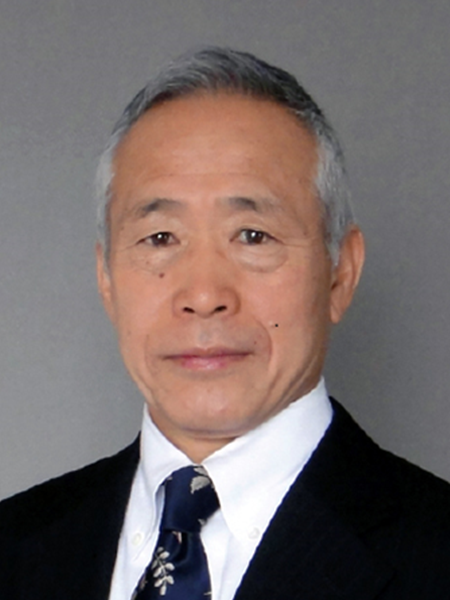
It is a true honor for me to receive the International Prize for Biology today. I also feel great pride to have been granted this Prize as a researcher in fish biology, with its many opportunities to come into contact with the research results of His Majesty the Emperor Emeritus. My deep appreciation goes first of all to those involved in conferring this honor.
When I was a child, I came upon a large fish in a small stream in my hometown area, swimming with its back appearing above the water. When I drew closer, the fish made a giant leap, and with a magnificent sheet of spray, swam off into the green depths. Looking back at that moment, that was the starting point on my way to becoming a researcher who is fascinated with the way animals move, and their travels.
In graduate school, under the guidance of Professor KAJIHARA Takeshi of the Ocean Research Institute of the University of Tokyo, I carried out research on the swimming physiology of fish, using a stamina tunnel. After that, through my studies of ayu (Plecoglossus altivelis) stemming from my desire to observe fish swimming in nature, I developed an interest in fish that migrate between oceans and rivers. Whereas ayu spend only their early life stage in the ocean, masu salmon (Oncorhynchus masou) spawn in a river but grow up in the ocean, while Japanese eels (Anguilla japonica) spawn in the ocean and spend most of their life in river water. I came to think that by comparing these three types, I could achieve an understanding of the essence of their travels, known as diadromy or diadromous migration. During the course of my research, however, I found myself drawn into trying to elucidate the ecology of eels, for which at that time little was known, not even the timing or location of their spawning.
Age analysis using otoliths (ear stones) revealed the spawning season of the Japanese eel to be in summer. Based on this evidence, in 1991 our team chose the summer season, unlike previous studies, to conduct research cruises covering a broad area of the western North Pacific, on the newly built research vessel Hakuho Maru of the Ocean Research Institute of the University of Tokyo. Through these efforts, we were able to collect approximately 1,000 eel leptocephali (transparent leaf-like larvae), around two weeks after hatching, showing conclusively that the Japanese eel spawning takes place around the West Mariana Ridge. The exhilaration we felt back then as we shared our joy aboard the ship is still clear in my memory. Yet, until we discovered newly hatched eggs or spawning adults, we could not say unequivocally that we had found their spawning grounds. We also felt a strong curiosity of wanting to see what no human being had seen before. Based on various data collected to date, we proposed two hypotheses, the Seamount Hypothesis and the New Moon Hypothesis. Together, these predicted that Japanese eels would spawn in early summer near the seamount areas of the West Mariana Ridge during the darkness of the new moon period. Thereafter, we spent each year aboard the research ship surveying around the Mariana Ridge, in early summer during the new moon period. Then in June 2005 we collected tiny leptocephali that had just hatched during the new moon, followed in May 2009 by our success in collecting naturally spawned Japanese eel eggs during the new moon, for the first time in the world. Both of these collections occurred along the southern edge of the West Mariana Ridge, confirming the validity of the New Moon Hypothesis and the Seamount Hypothesis.
Today our understanding of the spawning ecology of eels has advanced considerably. Looking back, I can see that our investigations of Japanese eel spawning areas relied not only on a scientific approach, but were a science adventure in which luck and intuition were indispensable. The ocean is vast and still contains numerous mysteries. I am full of high expectations for new adventures by the next generation of scientists.
Research cruises in the South Pacific, Indian Ocean, and the seas around Indonesia enabled us to learn a little about the spawning migration of eels living in the tropics, which had previously remained totally unknown. We also clarified the process of evolution of their migratory behavior and developed technology for artificial eel seedling production, as extinction fears are rising. For me, research is behavior aimed at satisfying my own extremely personal desire to learn, and an activity I cannot live without. Today, I am happy anew that I became a scientist. Along with my gratitude for this good fortune, I would like to express my heartfelt appreciation to all those who have afforded me this opportunity. Thank you very much.
When I was a child, I came upon a large fish in a small stream in my hometown area, swimming with its back appearing above the water. When I drew closer, the fish made a giant leap, and with a magnificent sheet of spray, swam off into the green depths. Looking back at that moment, that was the starting point on my way to becoming a researcher who is fascinated with the way animals move, and their travels.
In graduate school, under the guidance of Professor KAJIHARA Takeshi of the Ocean Research Institute of the University of Tokyo, I carried out research on the swimming physiology of fish, using a stamina tunnel. After that, through my studies of ayu (Plecoglossus altivelis) stemming from my desire to observe fish swimming in nature, I developed an interest in fish that migrate between oceans and rivers. Whereas ayu spend only their early life stage in the ocean, masu salmon (Oncorhynchus masou) spawn in a river but grow up in the ocean, while Japanese eels (Anguilla japonica) spawn in the ocean and spend most of their life in river water. I came to think that by comparing these three types, I could achieve an understanding of the essence of their travels, known as diadromy or diadromous migration. During the course of my research, however, I found myself drawn into trying to elucidate the ecology of eels, for which at that time little was known, not even the timing or location of their spawning.
Age analysis using otoliths (ear stones) revealed the spawning season of the Japanese eel to be in summer. Based on this evidence, in 1991 our team chose the summer season, unlike previous studies, to conduct research cruises covering a broad area of the western North Pacific, on the newly built research vessel Hakuho Maru of the Ocean Research Institute of the University of Tokyo. Through these efforts, we were able to collect approximately 1,000 eel leptocephali (transparent leaf-like larvae), around two weeks after hatching, showing conclusively that the Japanese eel spawning takes place around the West Mariana Ridge. The exhilaration we felt back then as we shared our joy aboard the ship is still clear in my memory. Yet, until we discovered newly hatched eggs or spawning adults, we could not say unequivocally that we had found their spawning grounds. We also felt a strong curiosity of wanting to see what no human being had seen before. Based on various data collected to date, we proposed two hypotheses, the Seamount Hypothesis and the New Moon Hypothesis. Together, these predicted that Japanese eels would spawn in early summer near the seamount areas of the West Mariana Ridge during the darkness of the new moon period. Thereafter, we spent each year aboard the research ship surveying around the Mariana Ridge, in early summer during the new moon period. Then in June 2005 we collected tiny leptocephali that had just hatched during the new moon, followed in May 2009 by our success in collecting naturally spawned Japanese eel eggs during the new moon, for the first time in the world. Both of these collections occurred along the southern edge of the West Mariana Ridge, confirming the validity of the New Moon Hypothesis and the Seamount Hypothesis.
Today our understanding of the spawning ecology of eels has advanced considerably. Looking back, I can see that our investigations of Japanese eel spawning areas relied not only on a scientific approach, but were a science adventure in which luck and intuition were indispensable. The ocean is vast and still contains numerous mysteries. I am full of high expectations for new adventures by the next generation of scientists.
Research cruises in the South Pacific, Indian Ocean, and the seas around Indonesia enabled us to learn a little about the spawning migration of eels living in the tropics, which had previously remained totally unknown. We also clarified the process of evolution of their migratory behavior and developed technology for artificial eel seedling production, as extinction fears are rising. For me, research is behavior aimed at satisfying my own extremely personal desire to learn, and an activity I cannot live without. Today, I am happy anew that I became a scientist. Along with my gratitude for this good fortune, I would like to express my heartfelt appreciation to all those who have afforded me this opportunity. Thank you very much.
Distinguished guests, ladies and gentlemen:
On behalf of the Selection Committee for the 38th International Prize for Biology, it gives me great pleasure to report on this year’s selection process.
The Selection Committee comprised twenty members, including myself and four overseas researchers.
This year’s field of specialization for the Prize was the Biology of Fishes. To obtain recommendations of suitable candidates, the Committee distributed a total of 1,587 recommendation forms to Japanese and foreign universities, research centers, academic associations, international academic organizations, and others. A total of 58 recommendations were received in response. After excluding recommendations naming the same individuals, the number of persons recommended was 49, from 22 countries and regions.
The Selection Committee met for a total of four times. After carefully reviewing all the candidates, the Committee recommended Professor Emeritus TSUKAMOTO Katsumi to the Prize Committee as the recipient of the 38th International Prize for Biology.
After obtaining his doctoral degree at graduate school of the University of Tokyo, Professor Emeritus Tsukamoto taught for many years in the Ocean Research Institute, currently the Atmosphere and Ocean Research Institute, of the University of Tokyo. He is presently Professor Emeritus, the University of Tokyo.
Professor Emeritus Tsukamoto, through his studies of migratory fish that move between oceans and rivers, is regarded as having established a scholarly foundation for understanding the basic principles of fish migration and the evolution of migratory behavior, thereby contributing greatly to the advancement of fish biology. Professor Emeritus Tsukamoto also developed a research cruise plan incorporating a new method for surveying vast areas of the ocean and found for the first time in the world that the Japanese eel (Anguilla japonica) spawn around the West Mariana Ridge.
In addition to these celebrated achievements, he developed technology for artificial mass production of glass eel seedlings for use in aquaculture, aimed at ensuring a stable supply of eels. He also wrote an essay for a fourth-grade Japanese textbook, and has travelled around Japan conducting classes called the “Eel Caravan” at nearly 300 elementary schools to stimulate interest of children in marine studies, as part of his many contributions to society and education.
The selection criteria for this Prize consisted of the relevance of the candidate’s research to the selected field of biology, its originality, its influence on that field of biology, and its contribution to advancing biological science as a whole. Professor Emeritus Tsukamoto’s work more than amply satisfied all these selection criteria.
Based on our recommendation, the Committee on the International Prize for Biology deliberated and decided to award the 38th International Prize for Biology to Professor Emeritus TSUKAMOTO Katsumi.
With this, I conclude my report on the process of the Prize selection.
On behalf of the Selection Committee for the 38th International Prize for Biology, it gives me great pleasure to report on this year’s selection process.
The Selection Committee comprised twenty members, including myself and four overseas researchers.
This year’s field of specialization for the Prize was the Biology of Fishes. To obtain recommendations of suitable candidates, the Committee distributed a total of 1,587 recommendation forms to Japanese and foreign universities, research centers, academic associations, international academic organizations, and others. A total of 58 recommendations were received in response. After excluding recommendations naming the same individuals, the number of persons recommended was 49, from 22 countries and regions.
The Selection Committee met for a total of four times. After carefully reviewing all the candidates, the Committee recommended Professor Emeritus TSUKAMOTO Katsumi to the Prize Committee as the recipient of the 38th International Prize for Biology.
After obtaining his doctoral degree at graduate school of the University of Tokyo, Professor Emeritus Tsukamoto taught for many years in the Ocean Research Institute, currently the Atmosphere and Ocean Research Institute, of the University of Tokyo. He is presently Professor Emeritus, the University of Tokyo.
Professor Emeritus Tsukamoto, through his studies of migratory fish that move between oceans and rivers, is regarded as having established a scholarly foundation for understanding the basic principles of fish migration and the evolution of migratory behavior, thereby contributing greatly to the advancement of fish biology. Professor Emeritus Tsukamoto also developed a research cruise plan incorporating a new method for surveying vast areas of the ocean and found for the first time in the world that the Japanese eel (Anguilla japonica) spawn around the West Mariana Ridge.
In addition to these celebrated achievements, he developed technology for artificial mass production of glass eel seedlings for use in aquaculture, aimed at ensuring a stable supply of eels. He also wrote an essay for a fourth-grade Japanese textbook, and has travelled around Japan conducting classes called the “Eel Caravan” at nearly 300 elementary schools to stimulate interest of children in marine studies, as part of his many contributions to society and education.
The selection criteria for this Prize consisted of the relevance of the candidate’s research to the selected field of biology, its originality, its influence on that field of biology, and its contribution to advancing biological science as a whole. Professor Emeritus Tsukamoto’s work more than amply satisfied all these selection criteria.
Based on our recommendation, the Committee on the International Prize for Biology deliberated and decided to award the 38th International Prize for Biology to Professor Emeritus TSUKAMOTO Katsumi.
With this, I conclude my report on the process of the Prize selection.
To mark the awards to Drs. White and Tsukamoto, Commemorative Symposiums for the 37th and 38th International Prize for Biology were held on December 17 and 18, 2022, in Tokyo at The University of Tokyo and in Aichi at Okazaki Conference Center, respectively.

The 37th Symposium co-organized by The University of Tokyo and JSPS
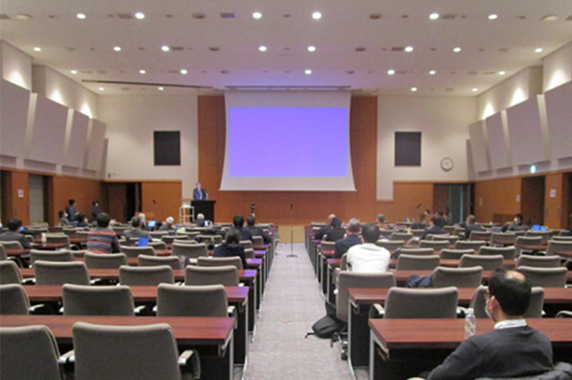
The 38th Symposium co-organized by National Institute for Basic Biology and JSPS

